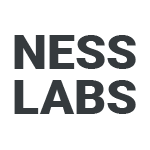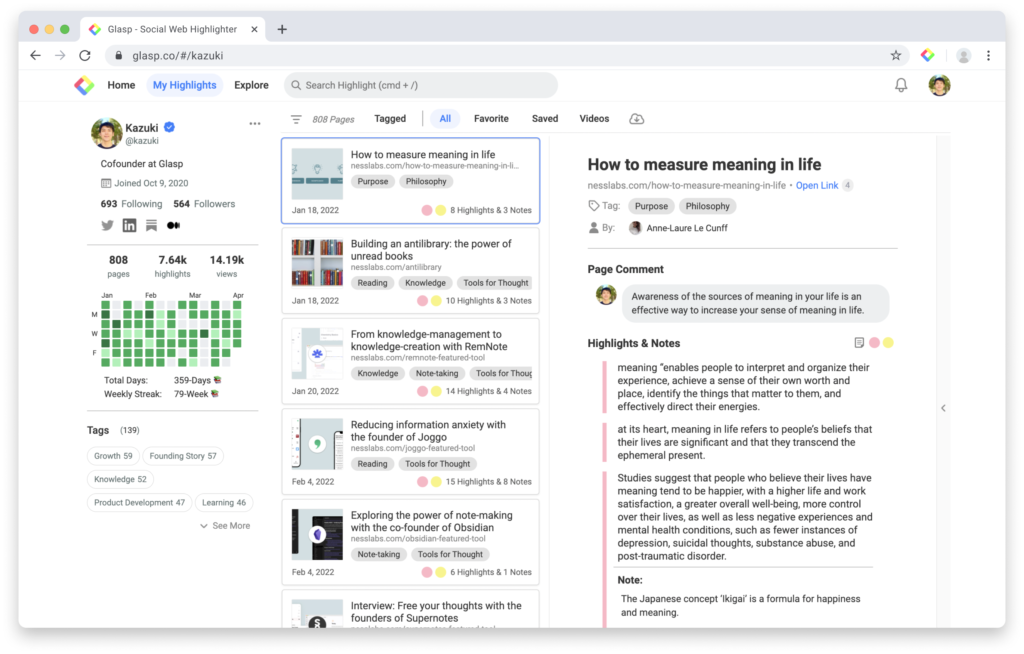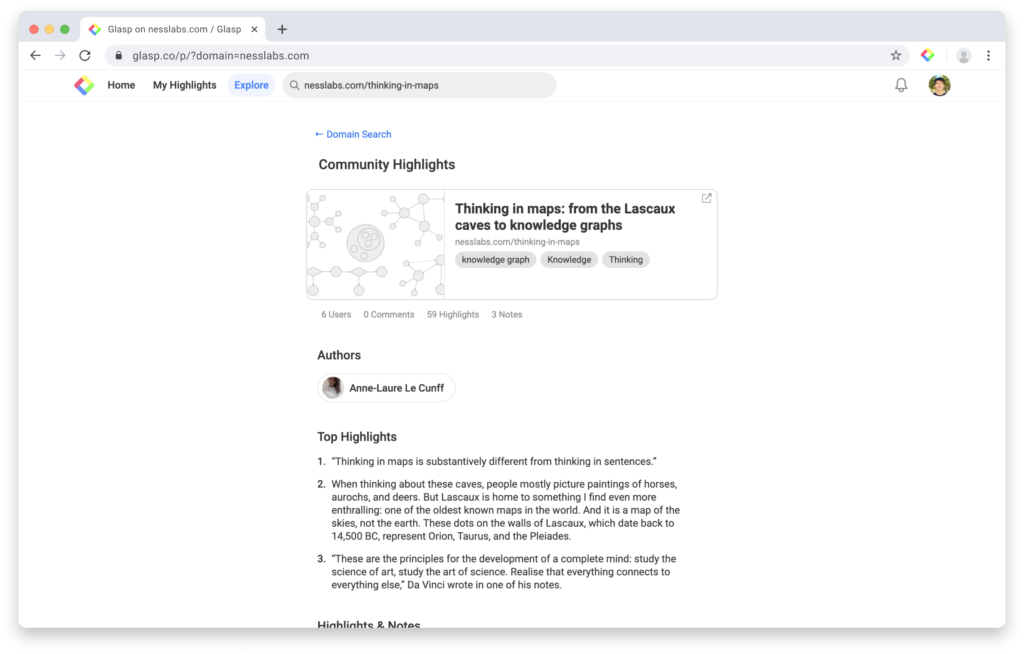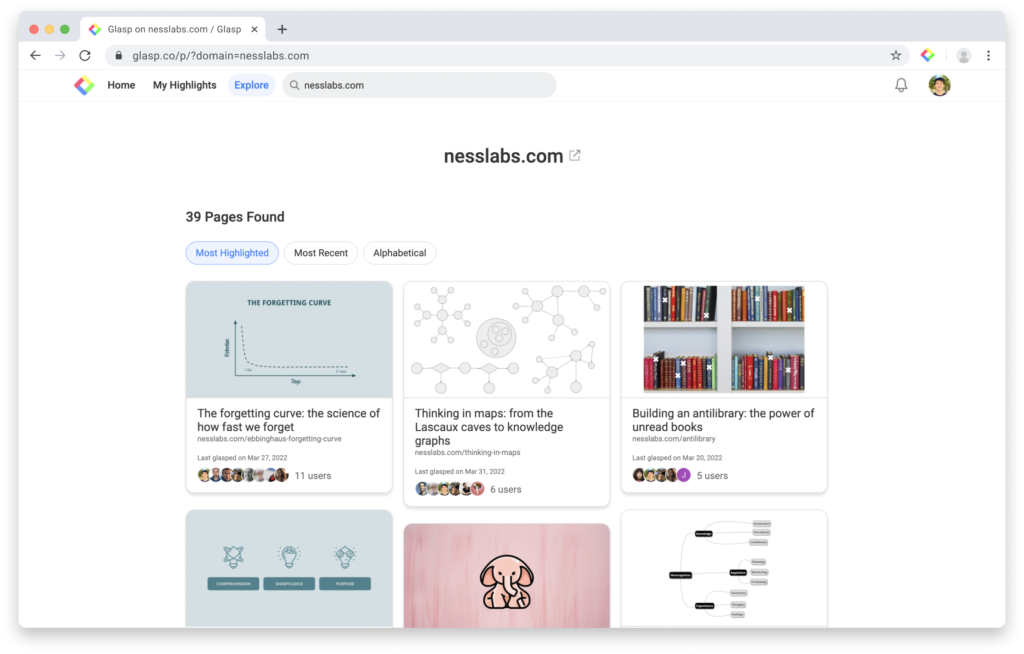Welcome to this edition of our Tools for Thought series, where we interview founders on a mission to help us think better and achieve their intellectual and creative ambitions. Kazuki Nakayashiki is the co-founder of Glasp, a social web clipper that allows users to share their highlights and notes as they read, without any back-and-forth between the web and a note-taking app.
In this interview, we talked about the nature of human legacy, the knowledge isolation problem, serendipitous spaced repetition, social knowledge management and collective intelligence, learning in public, the impact of social accountability on note-taking, and more. Enjoy the read!
Hi Kazuki, thank you so much for agreeing to this interview. Glasp stands for “Greatest Legacy Accumulated as Shared Proof” — can you tell us more about what it means?
Thank you so much for having me. I am a huge fan of Ness Labs and I am honored to be here today. First of all, we believe that one of the most noble pursuits is for people to learn, experience, and pass their knowledge on to future generations. The present in which we stand today is built on what our predecessors have built in the past.
When we talk about legacy, it does not necessarily mean to leave a successful business or a lot of money behind. Of course, it is wonderful to be able to leave these things to future generations, but I don’t believe that these are the greatest legacies, in that not everyone can leave them behind.
Instead, I believe that the greatest legacy is to live a courageous life. It is in the attitude of not being daunted by difficulties, not being overly pessimistic, and betting on the possibilities and hopes of humanity. And I believe this means leaving and weaving our knowledge, wisdom, and history for the next generation.
However, even though we are standing on the shoulders of our predecessors, we do not know how or by whom all that knowledge was accumulated. Through Glasp, we want to empower people to leave, share, and weave the greatest legacy. Our mission is to democratize access to other people’s learning and experiences that they have collected throughout their lives. By doing so, we may be able to help others who may try to follow a similar path in the future.
This is an ambitious mission. Was there an “aha” moment that inspired you to build Glasp?
I had a near-death experience at the age of 20 when I had a sudden subdural hematoma that paralyzed the left side of my body. My doctor at the time told me that I could have a cardiopulmonary arrest at any moment, and I was hospitalized and underwent emergency surgery. I remember the sense of fear and emptiness that welled up from the depths of my body, which words cannot express, as I was confronted with the reality that the normalcy of yesterday was suddenly taken away from me and that my existence might disappear from this world.
Since that time, I have wanted to leave behind a legacy that would allow me to feel that I have made even a small contribution to the future of humanity — a legacy that would be the proof and meaning of my existence in this world.
I do not know if what I leave behind is really useful to anyone. It is a matter of subjectivity. However, just as someone’s trash is someone else’s treasure, I believe that by leaving my learning and experiences behind, they can become useful to someone somewhere in the future.
If you leave your knowledge, wisdom, and insight in a completely personal space, no one will be able to access it after you die. Given the fact that collective learning has made us humans smarter across generations, I think keeping knowledge in a silo is a huge loss for humanity as a whole. In other words, the problem we are addressing is the isolation of knowledge.
The world is full of countless wonderful personal apps, but my near-death experience and the process of searching for the meaning of life led me to the current idea of Glasp.
That’s incredibly inspiring, thank you so much for sharing Glasp’s origin story. How does Glasp work exactly?
Glasp is a social web clipper that people can use to highlight and organize quotes and thoughts from the web without having to switch back and forth between screens, and access other like-minded people’s learning at the same time. You can get an idea of what Glasp is all about by looking at what our users are saying on the “Wall of Love” on the website.
After breaking our mission into specific components, we decided to focus on the overlap between curation, knowledge management, and community. Some of the advice I recently received from Jeremy Brown on Twitter overlaps with these components, as well as with Michael Simmons’ ideas of public note-taking and learning in public.
For curation, we currently offer a Chrome Extension and a Safari Extension, which, when installed, display a small popup like the Kindle’s highlighter when you select text, and will allow you to curate text that resonated with you. It allows for easy highlighting and note-taking without interrupting the reading experience.
When reading a particular article, all highlights and notes for that article can be viewed from the right sidebar, and be easily copied and pasted into note-taking apps, markdown style. You can also add tags and comments, and see what others have highlighted on that website directly on the page.
In terms of knowledge management, as you can see on my page, Glasp organizes your highlights and notes for you and allows you to filter by topic or full-text search, so you can easily access quotes, thoughts, ideas, and insights that you have found important in the past. The social nature of Glasp also allows you to access other people’s highlights and notes on your page (called “marginalia”), so you can build on others’ perspectives and deepen your knowledge. In the future, we plan to add a feature that will allow you to backlink your findings with your past highlights or those of others.
I also believe that the uniqueness and fun of Glasp’s approach to knowledge management lie in its ability to resurface what you have learned. Spaced repetition is one of the most proven methods for remembering what you have read, but the sad reality is that reviewing flashcards is tedious and setting up the system is cumbersome. With Glasp, others interact with your highlights, which provides accidental and automatic opportunities for review. This is unique in that other curators resurface your highlights, and I think it is also interesting that the curators resurface the creator’s work.
As for community, Glasp allows you to connect and learn from other people with similar interests through the learning byproduct: highlights and notes. Glasp’s home feed allows you to see what the people you are following are learning and what insights they have gained. You can also search content by topic, so you can see what friends, colleagues, influencers, and other people you trust or who share similar interests are learning.
You can check each site’s top highlights and find your favorite authors as well. In particular, newsletter writers or content writers can share their learning process with Glasp (called “learning in public”). Deep engagement and direct feedback from audiences and followers can be a great way to get ideas and inspiration for their future content.
Having learning partners is very inspiring and fun. Glasp can enhance one’s learning process by making the learning process social. For example, we are collaborating with the Month to Master learning cohort program run by Michael Simmons to help learners weave and share what they learned.
When it comes to bookmarking and highlighting, a big challenge is that many people end up building a graveyard of random links they never end up actually learning from. How does Glasp address this challenge?
As you say, too often we see the issue of saving random links leading to this dysfunction, and I think this is a problem that is not limited to bookmarking and highlighting, but to our information society in general.
One important aspect is the difference between read-it-later apps and Glasp. There are two processes of information selection when we collect information. One is broad and shallow. The other is narrow and deep.
The former is an area where the read-it-later apps show their strength as a place to store a vast amount of information that is of some interest, is relevant, or may be useful in the future, in place of your short-term working memory. The latter is an area where Glasp and other highlighter apps can show their strength as a place to store important information that has passed the primary sifting process and that you want to keep for a longer period.
If the number of items to be stored is huge and their quality is not checked, it will be difficult to maintain, organize, and manage, and will most likely result in a graveyard of random links. Fortunately, Glasp’s user core action is not bookmarking, but the act of highlighting and leaving notes, so the action threshold for the user is not as light as for the bookmarking apps or read-it-later apps.
Furthermore, the possibility that highlights and notes may be seen by others creates social accountability, so the threshold of action for the user is raised even higher. When you hear the word “highlight”, you probably associate it with education. Those familiar with education may know that research shows that highlighting is not a very effective learning technique. However, research also suggests that the probability of effective highlighting increases when moderate incentives and pressure are designed in.
In other words, the pressure that someone might see your highlights works as a social accountability function, which can increase the likelihood of saving something better and more valuable to you. While some may argue that the volume of a person’s digital legacy may be reduced by this approach, we place more value on the insight, idea, emotion, and connection to a particular passage within the content, rather than just the act of liking or saving a link.
The real strength of digital highlighting lies not in the act of highlighting the text itself, but in the ability to search and access it later and find connections within it through backlinks and other means. From the perspective that knowledge is about entities and their relationships, it remains to be seen how much value there is in observing how many unconnected “dots” such as the number of unknown words and concepts that examinees have memorized, which is often used in research. There is room for debate, and I am not sure if we can conclude that the learning effect of highlighting is weak.
In essence, we are challenging the graveyard issue or the knowledge isolation problem through Glasp’s high core action threshold, the social accountability derived from public highlights, and the visualization of a person’s digital legacy’s contribution to human society using GitHub-like commitment panels.
And this is your vision of building a digital legacy.
Yes. As I mentioned earlier, we think it is very noble for people to learn, experience, and pass it on to future generations. From this perspective, we believe that systematically organizing and making accessible what a person has learned and the knowledge they have built throughout their lives would be the most effective approach to building their digital legacy. Of course, Glasp has a following and saving function, but its focus is on interest graphs and persistence based on knowledge building.
Even in traditional social media, a kind of digital legacy can be built passively through a person’s activities, and it’s great that people can easily leave their interests by liking something. On the other hand, these social media, due to their ephemeral nature and social graph-driven connections, place less emphasis on building lasting and trans-generational knowledge. For instance, if I ask you if you know any good resources about mental models or note-taking, though it depends on the topic, you may think of some articles, books, podcasts, or videos, but I guess not many would think of Twitter threads or LinkedIn posts that you liked in the past in the first hand.
As the Lindy effect says, what is truly valuable tends to persist over long periods, and in that respect, I think the traditional method of information flowing ephemerally is not a good match for building a digital legacy in terms of knowledge building and flourishing. At Glasp, we hope to create a platform that allows the next generation to build and access knowledge based on topic and interest itself regardless of time.
Many knowledge workers already use a note-taking tool. How does Glasp integrate with other tools for thought?
We are not looking to replace or disrupt note-taking apps. We really appreciate that those great note-taking apps exist. Rather, we hope that Glasp augments them. For instance, Glasp’s markdown-supported copy-and-paste functionality allows you to export only the important parts of a document, such as highlights and notes, into a note-taking application, rather than the full text.
Also, since it picks up metadata such as the title and URL of the article, you can simultaneously leave your learning byproducts such as highlights and notes on Glasp as a legacy for future generations without interrupting the existing flow of your note-taking app. This way, you can potentially contribute to human knowledge history without changing your workflow!
That sounds wonderful! Can you tell us about how you make product design decisions?
All decisions regarding products, including design, are based on whether they are in line with the mission. Our mission is always our north star. In terms of feedback, we regularly call our users to gather their comments and suggestions. Sometimes we ask if we can call them, and sometimes they schedule a call through the “Talk to Founders” button on the web app.
We used to do onboarding calls with all signup users. Now we are a team of three people, and due to the limited resources we are not able to implement all ideas, but we keep all feedback we receive in a backlog. We often get inspiration from this backlog.
I also get design inspiration from GitHub, Wikipedia, Pinterest, Twitter, Goodreads, Kindle, and other apps that I feel are close in mission, direction, or area. Although I design most of the UI, I am not an expert in design, so some aspects of my design may seem inconsistent. If anyone has any good ideas, I would love to hear from you.
What kind of people use Glasp?
The main users are avid readers, active note-takers, writers, and lifelong learners.They tend to be hard-working and studious, and they tend to keep what they have learned on specific topics of personal interest, such as note-taking, psychology, product management, founding stories, and so on.
It seems to me that quality content comes from many different places on the Internet, from well-known domains like Wikipedia and Ness Labs to domains I have never heard of. It now has over 150,000 highlights (“digital legacies”) on over 20,000 unique links. Several users have thanked us for the interesting and insightful content they have come across using Glasp, which they never would have encountered before.
Other interesting use cases are those by people like Ev Chapman and Michael Simmons who run newsletters and blogs. It is interesting to see how content creators and their audiences learn from each other and pile on highlights (i.e., when someone highlights through their following people’s highlights). The social nature of Glasp is the starting point for content writers to connect directly with their audiences, receive feedback, and get inspiration for future posts, and I think this is an interesting aspect of Glasp.
What about you… How do you personally use Glasp?
My recent topics of interest include psychology, note-taking, and learning in public, and when I find content on these topics, I skim through it first, and if I find a particular passage that really resonates with me, or that I want to keep for future reference, I highlight the passage or leave a note. Then, in the second read, if I think “this reminds me of a concept mentioned in another article” for a particular sentence, I leave a note with a related link or a past highlight. Then, I tag it and sometimes leave a summary for future me or future readers.
If I’m curious about what others thought and learned from the content I highlighted or found interesting, I go to Glasp’s community page for insights on that content. It is fascinating to see how different people feel and think about the same content. The more perspectives I get, the deeper my understanding of the topic becomes.
In addition, because of the high threshold of core action in Glasp, I leave what I think is really good, so when I want to research something, I first search for it on my page in Glasp. The more time I spend, the more information I gather on a particular topic, which is helpful because each time I search, I discover new connections and have immediate access to important information.
I can also share my highlights and notes related to a particular topic via a unique URL, so when a friend or colleague asks me about something, I share that link with them so they can access the content that I think is important. Of course, I may also search on other users’ pages as well. It is interesting to peek into what others are learning and what they find important because I feel like I’m looking into their brain by accessing their digital legacy.
Currently, we send our users the Glasp Weekly Newsletter twice a week with three good articles we read that week. With Glasp, the highlights and notes about what I learned are all in one place, so it is very easy for me to create a newsletter. Basically, what you need is to copy-and-paste highlights, notes, or comments into the body of the newsletter.
Therefore, if you are a newsletter writer or content writer and regularly share the articles you read with your audience, it will be easier for you to create a newsletter, and you can also share the inspiration and learning process that led to its creation.
There’s still so much work to improve the way we learn together and increase our collective intelligence. Where would you like Glasp to be in the next few years?
We want to spend our lives working on Glasp’s mission. It will take quite a long time and there are still many obstacles to overcome. In terms of leaving a digital legacy for future generations, we think that we need a system that allows data to be stored long-term, secure, and easily accessible.
Perhaps a decentralized technology such as blockchain or something equivalent will be necessary. Or carving it on a stone slab might work as a backup. The team is still discussing sustainability and long-term permanence in this area, but we hope to find a way to break through over time.
Hopefully, in the next few years, we will be one step closer to being like another social profile that shows your learning footprint and like a next-generation search engine that allows you to search from the digital legacy left behind by people whom you trust or follow.
I also believe that if we can visualize, like a family tree, where people get their information from and how and to whom what they have learned has been passed on, we will be able to visualize their contribution to human society.
It would be very moving to be able to see how what one’s grandparents and great-grandparents left behind has been transmitted to oneself and to society over the generations, and it would be interesting to see how what one leaves behind is passed on to one’s grandchildren and great-grandchildren. Nothing would make me happier than to see even a small increase in the number of people who find meaning and value in their lives through Glasp.
This is a beautiful mission. Thank you so much for your time, Kazuki! Where can people learn more about Glasp and give it a try?
Thank you so much for having me! You can check out Glasp on the web at glasp.co. We have Chrome Extension and Safari Extension. It’s totally free. Also, we are active on social media (Twitter, Linkedin) and try to keep our community in the loop whenever we have updates. I’m really excited to hear the Ness Labs community’s feedback through Glasp!



